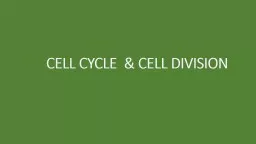

CELL CYCLE The sequence of events by which a cell duplicates its genome synthesis the other constituents of the cell and eventually divides into two daughter cells Phases of cell cycle Interphase ID: 912090
Download Presentation The PPT/PDF document "CELL CYCLE & CELL DIVISION" is the property of its rightful owner. Permission is granted to download and print the materials on this web site for personal, non-commercial use only, and to display it on your personal computer provided you do not modify the materials and that you retain all copyright notices contained in the materials. By downloading content from our website, you accept the terms of this agreement.
Slide1
CELL CYCLE & CELL DIVISION
Slide2CELL CYCLE
The sequence of events by which a cell duplicates its genome, synthesis the other constituents of the cell and eventually divides into two daughter cells.
Slide3Phases of cell cycle :
•Interphase :
G1 Phase: Cell metabolically active and grows continuously.
•
S Phase:
DNA synthesis occurs.
DNA content increases from 2C to 4C.but the number of chromosomes remains same (2N).
•G2 Phase:
Proteins are synthesized in preparation for mitosis while cell growth continues.
Slide4•M Phase (Mitosis Phase): Starts with nuclear division, corresponding to separation of daughter chromosomes (
karyokinesis
) and usually ends with division of cytoplasm (cytokinesis). •Quiescent stage (G0): Cells that do not divide and exit G1 phase to enter an inactive stage called G0. Cells at this stage remain metabolically active but do not proliferate.
Slide5MITOSIS
•Prophase :
◦Replicated chromosomes, each consisting of 2 chromatids, condense and become visible.◦Microtubules are assembled into mitotic spindle.◦Nucleolus and nuclear envelope disappear.
◦Centriole moves to opposite poles.
Slide6Metaphase :
◦Spindle fibres attached to kinetochores (small disc-shaped structures at the surface of
centromers) of chromosomes.◦Chromosomes line up at the equator of the spindle to form metaphase plate.
•
•
Slide7Slide8Anaphase :
◦Centromeres split and chromatids separate.
◦Chromatids move to opposite poles.
Slide9•
Telophase
◦Chromosomes cluster at opposite poles.◦Nuclear envelope assembles around chromosome cluster.◦Nucleolus, Golgi complex, ER reform.
Slide10Cytokinesis :
Is the division of protoplast of a cell into two daughter cells after
Karyokinesis (nuclear division).•Animal cytokinesis : Appearance of furrow in plasma membrane which deepens and joins in the centre dividing cell cytoplasm into two.
•Plant cytokinesis :
Formation of new cell wall begins with the formation of a simple precursor − cell plate which represents the middle lamella between the walls of two adjacent cells
Slide11Significance of Mitosis :
.
•Growth − addition of cells.•Maintenance of surface/volume ratio.•Maintenance of chromosome number.•Regeneration.
•Reproduction in unicellular organism.
•Repair and wound healing.
Slide12MEIOSIS
•
Specialized kind of cell division that reduces the chromosome number by half, resulting in formation of 4 haploid daughter cells.•Occurs during gametogenesis in plants and animals.•Involves two sequential cycles of nuclear and cell division called Meiosis I and Meiosis II.•Interphase occurs prior to meiosis which is similar to interphase of mitosis except the S phase is prolonged.
•4 haploid daughter cells are formed.
Slide13Slide14Meiosis I
Prophase I : Subdivided into 5 phases.
Leptotene :•Chromosomes make their as single stranded structures.•Compaction of chromosomes continues.
Slide15Zygotene
:
•Homologous chromosomes start pairing and this process of association is called synapsis.•Chromosomal synapsis is accompanied by formation of synaptonemal complex.•Complex formed by a pair of synapsed homologous chromosomes is called bivalent or tetrad.
Slide16Pachytene
:
•Crossing over occurs between non-sister chromatids of homologous chromosomes.Diplotene : •Dissolution of synaptonemal complex occurs and the recombined chromosomes separate from each other except at the sites of crossing over. These X-shaped structures are called
chaismata
.
Slide17Diakinesis
:
•Terminalisation of chaismata.•Chromosomes are fully condensed and meiotic spindles assembled.•Nucleolus disappears and nuclear envelope breaks down.
Slide18Metaphase I :
•Bivalent chromosomes align on the equatorial plate.
•Microtubules from opposite poles of the spindle attach to the pair of homologous chromosomes.Anaphase I: •Homologous chromosomes separate while chromatids remain associated at their centromeres.Telophase
I :
•Nuclear membrane and nucleolus reappear.
•Cytokinesis follows (
diad
of cells).
Slide19Interkinesis
:
Stage between two meiotic divisions. (Meiosis I and meiosis II)Meiosis llProphase ll
•Nuclear membrane disappears.
•Chromosomes become compact.
Metaphase
ll
•Chromosomes align at the equator.
•Microtubules from opposite poles of spindle get attached to kinetochores of sister chromatids.
Slide20Anaphase
ll
•Simultaneous splitting of the centromere of each chromosome, allowing them to move towards opposite poles of the cell.Telophase ll•Two groups of chromosomes get enclosed by a nuclear envelope.
•Cytokinesis follows resulting in the formation of tetrad of cells i.e., 4 haploid cells.
Slide21Significance of Meiosis
•
Formation of gametes: In sexually reproducing organisms.•Genetic variability•Maintenance of chromosomal number: By reducing the chromosome number in gametes. Chromosomal number is restored by fertilisation of gametes.